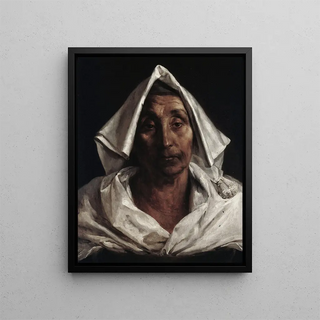Art print | The Old Italian Woman - Théodore Géricault


View from behind

Frame (optional)
In the vibrant universe of early 19th-century art, the art print "La vieille femme italienne" by Théodore Géricault stands out for its emotional depth and striking realism. This painting, which captures the very essence of the human condition, immerses us in a world where beauty and melancholy coexist. Through the gaze of this elderly woman, Géricault invites us to explore themes of vulnerability, dignity, and the inexorable passage of time. The art print of this iconic work allows us to rediscover a masterpiece often forgotten but deserving a prominent place in any art collection.
Style and uniqueness of the work
Géricault's style is characterized by a bold approach and meticulous attention to detail. "La vieille femme italienne" is no exception. The composition, both simple and powerful, highlights the expressive face of the protagonist, whose features are sculpted by years and hardships. Shadows and light play a crucial role in creating an intimate atmosphere, where every wrinkle tells a story. The subtle and nuanced color palette enhances the sense of depth and volume, making the figure almost tangible. This realism, which sometimes borders on naturalism, reflects the artist's commitment to portraying human truth in all its complexity.
The artist and his influence
Théodore Géricault, an emblematic figure of Romanticism, marked his era with daring works and innovative thematic choices. Born in 1791, he established himself as a pioneer, exploring subjects often considered taboo. His interest in human psychology and his desire to depict the suffering and anguish of his contemporaries allowed him to create works that still resonate today. "La vieille femme italienne" exemplifies this quest for truth, where Géricault seeks to capture the soul of his subjects. His influence extends far beyond his time, inspiring generations of artists to explore the depths of human emotion and question the aesthetic conventions of their era.
A wall decoration

Matte finish

View from behind

Frame (optional)
In the vibrant universe of early 19th-century art, the art print "La vieille femme italienne" by Théodore Géricault stands out for its emotional depth and striking realism. This painting, which captures the very essence of the human condition, immerses us in a world where beauty and melancholy coexist. Through the gaze of this elderly woman, Géricault invites us to explore themes of vulnerability, dignity, and the inexorable passage of time. The art print of this iconic work allows us to rediscover a masterpiece often forgotten but deserving a prominent place in any art collection.
Style and uniqueness of the work
Géricault's style is characterized by a bold approach and meticulous attention to detail. "La vieille femme italienne" is no exception. The composition, both simple and powerful, highlights the expressive face of the protagonist, whose features are sculpted by years and hardships. Shadows and light play a crucial role in creating an intimate atmosphere, where every wrinkle tells a story. The subtle and nuanced color palette enhances the sense of depth and volume, making the figure almost tangible. This realism, which sometimes borders on naturalism, reflects the artist's commitment to portraying human truth in all its complexity.
The artist and his influence
Théodore Géricault, an emblematic figure of Romanticism, marked his era with daring works and innovative thematic choices. Born in 1791, he established himself as a pioneer, exploring subjects often considered taboo. His interest in human psychology and his desire to depict the suffering and anguish of his contemporaries allowed him to create works that still resonate today. "La vieille femme italienne" exemplifies this quest for truth, where Géricault seeks to capture the soul of his subjects. His influence extends far beyond his time, inspiring generations of artists to explore the depths of human emotion and question the aesthetic conventions of their era.
A wall decoration






